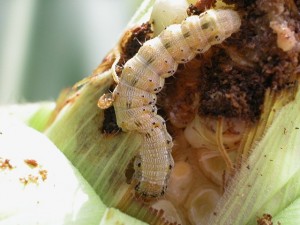It is a common practice to spray an insecticide on field corn during early tasseling when making a fungicide application. I often get no answer when I ask a grower what pest he is spraying. Just as commonly I’m told they are trying to control corn earworm, Japanese beetles or corn borers. This application is often made without regard to pest populations, and thus even if needed, is poorly timed.
So when does it pay to spray tasseling field corn with insecticide? There is little question that treating for southwestern or European corn borers in non-Bt corn can improve yields if corn borers are present in high enough numbers. I’ve got many examples of 10-40 bushel/acre yield increases from one application in the presence of moderate to high populations. This is why I so strongly promote the use of southwestern corn borer pheromone traps around fields of non-Bt corn. Insecticides such as Belt, Prevathon, Besiege and Intrepid provide better residual control than the pyrethroid insecticides. Thus, you may not be penalized as severely for poorly timed applications (providing they are not too late). However, it is common to have low corn borer infestations even in non-Bt corn. Don’t spray a field just because it is non-Bt. I’ve recently written an article about interpreting trap catches and managing corn borers in non-Bt corn (link here).

So what about Bt corn? I really struggle here to find a good reason to spray Bt corn. This should be the exception and not the rule. The Bt technologies take corn borers out of the equation, providing near perfect control. Japanese beetles may very occasionally do enough silk clipping to justify treatment (see related article). Many Bt corn technologies provide pretty good control on populations of fall armyworm or corn earworm, and let’s face it, fall armyworm is really only a common problem on late planted corn in Tennessee. And a one-time treatment for corn earworm with the intent of reducing kernel injury just doesn’t work. I’ve tried repeatedly and so have many others (for decades). It takes multiple applications, regardless of the insecticide you choose, to reduced corn earworm populations and kernel damage within the ear. I have had one experiment where a single insecticide application reduced kernel injury in non-Bt corn. Even in this case it did not improve yield. Many other experiences suggest that a single insecticide application has NO effect on kernel injury or yield, and the higher the corn earworm pressure, the less likely they are to work! The newer Bt technologies such as SmartStax, VT3Pro and Viptera are better at reducing kernel injury by corn earworm and fall armyworm. Even then, I cannot show you one example in Tennessee where the new Bt corn technologies yielded significantly better than the older Bt traits with the same genetic background. Never say never, but the long and short of it is, kernel damaged by corn earworm is worse than it looks and hard to prevent.
There is some potential downside to spraying insecticides unnecessarily, besides the added cost, including selecting for resistance and flaring populations of secondary pests. Spider mites in particular are far more likely following applications of pyrethroid insecticides. Enough said?


One thought on “Are You Spraying Insecticides at Tassel Just Because?”
Comments are closed.